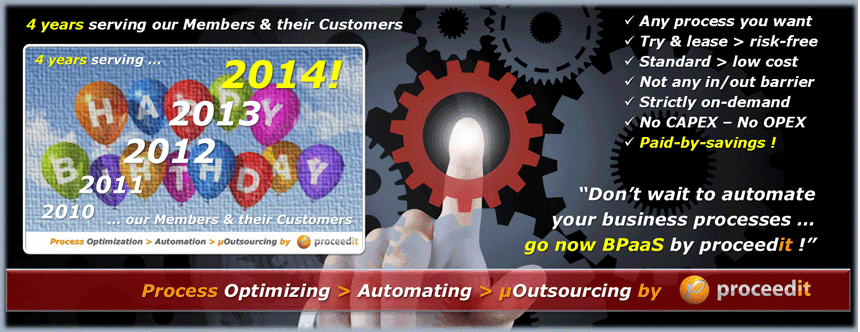As commented in
one of ours recent posts, by "BPM
Adoption" we understand the way that some organizations have
undertaken to relieve, optimize, automate and outsource part of their business
processes, with the ultimate aim of achieving and maintaining the Operational Excellence that ensure them
a sustainable competitive advantage.
To simplify our
analysis, we have grouped the various strategies of BPM Adoption usually followed by organizations in four archetypal
models, which we have called "Process
Team", "Cloud",
"Consulting" and "BPaaS".
Each model is
characterized by the decision organizations have made in terms of the Mode of Development of the automation
solutions, differentiating whether they do or plan to do by internal or
external means; and the Mode of Operation
of such automation solutions, differentiating if they do or plan to do either
on internal systems (on-premises) or
external (on Cloud or on an external Data Centre).
Under the “BPaaS” model, the last of the four BPM Adoption Models analyzed in this
series of posts, both the development of automation solutions and their
exploitation, are external, thus combining the features of the "Consulting" model and the "Cloud" models as it is shown in the
next figure:
Under this model
complete and integrated services are provide, but with two substantial
differences with other models:
- The automation solution, even is available as a more or less standard and packaged solution, although it requires some customization for each client (at least for the initial configuration and integration with corporate applications Client); or, the solution, that was initially developed for a first client, becomes standard, and then can be used in the future for third party customers with similar needs, again with the required customization for each new client.
- Other services called BPO (Business Process Operation and Business Process Outsourcing) can be incorporated into the value proposition of the service provider to provide them in the form of personal services that go beyond pure computer service applications.
In this case
then, the main and only external actor, is the so called BPaaS Services Operator Services, who integrates various products
and services, and builds a packaged offering, including the development,
customization and integration of applications and, in some cases, physical
operation of certain tasks in the business process in behalf of the Customer;
thus acting as prime contractor in front of the customer, for the various
products and services including personal ones, required to automate and operate
the corresponding business process.
Under this
model, the BPMS Platform used loses
most of its relevance (except giving prestige to the Operator and then security
and confidence to the Client), since what matters is that the solution is the best
suited to the client's needs with effortlessly development and customization
with maximum flexibility, and that the operator can meet the SLA (Service
Level Agreement) committed to the Customer.
Under this
scheme, many other tools appear on stage (OCR,
ICR, ECM, DMS, BRMS, DB, ESB, SSO, ...) to build the technological ecosystem
required for an automated, safe and efficient operation of the deployed
business processes.
The Cloud used in this model can be Public,
in which case, the security of Client data and documents are the responsibility
of the Operator and this delegates it to the data center providing IaaS and PaaS services.
However, many
customers prefer their data and documents remain on their own servers, whether
they installed internal (on-premises)
or external (Private Cloud), thus the
need to operate models Hybrid Cloud appears as a mixture of the Public Cloud
certain characteristics of on-premises.
In our opinion, the
standardization that allows the reuse of process automation solutions for all
business customers requiring this type of solution, is the key for this model being
sustainable and so successful, achieving significantly reduction of both CAPEX
(CAPital EXpenses) and OPEX (OPerating EXpenses) regarding to others BPM Adoption Models.










